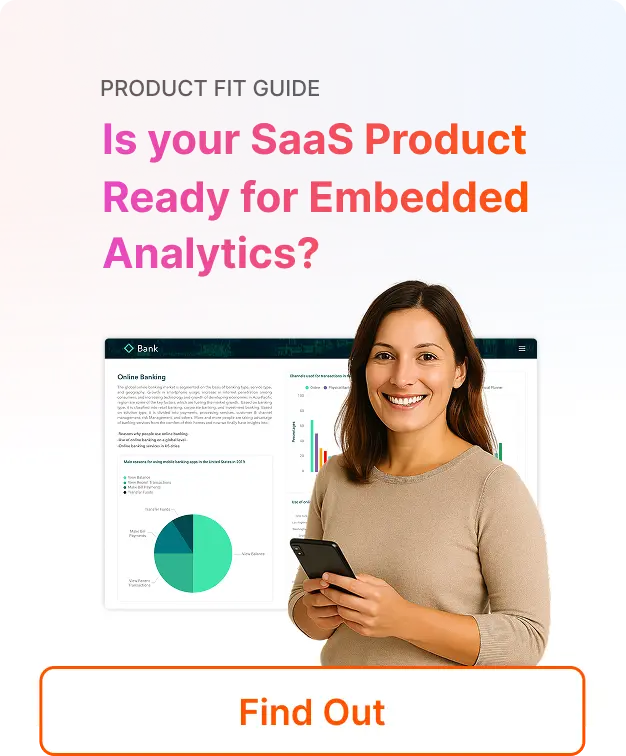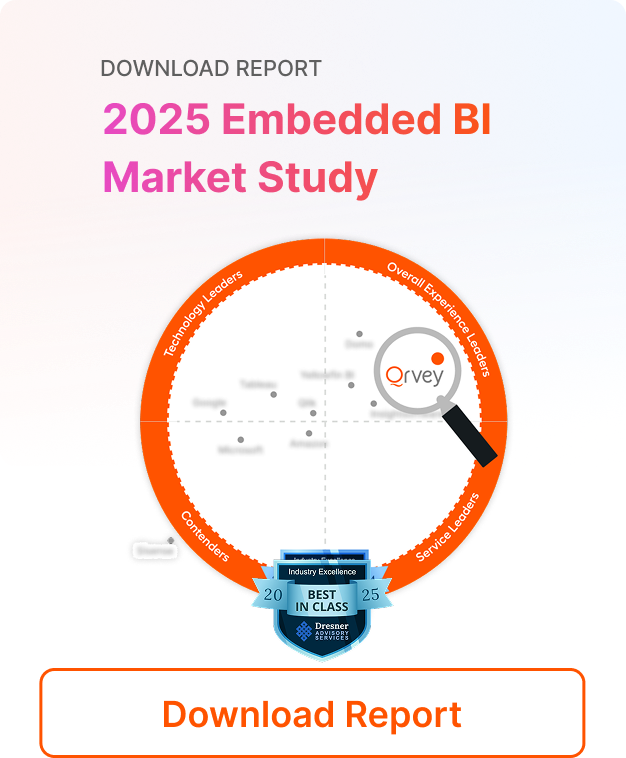
⚡Key Takeaways
- Data analytics modernization defined: Updating data infrastructure, tools, and processes to use more advanced analytics capabilities, enabling more data-driven decision-making
- 6 Benefits of data analytics modernization: More comprehensive insights and data-driven decision-making, improved productivity and collaboration, faster time to action, and more
- 5 Current data analytics problems: Data complexity, lack of scalability, implementation time, inability to analyze all data, and disjointed user experience
- 3 Examples: Data analytics modernization in practice
- Best practices for long-term success: Quick reference chart of “Dos and Don’ts”
Introduction
Like every facet of their app, SaaS providers must modernize their analytics. Data analytics modernization brings many benefits to end users and SaaS providers alike.
In this blog, we’ll provide helpful guidance on the problems and challenges which must be overcome. We also share examples of successful data analytics modernization in practice, along with a best practices reference chart listing Dos and Don’ts.
What Data Analytics Modernization Really Means
Data analytics modernization describes the process of updating and an organization’s data infrastructure, tools, and processes to use more advanced analytics capabilities. Modernizing analytics enables more data-driven decision-making.
Modernizing analytics can be accomplished many ways, including:
- Improving analytics by incorporating more data, such as unstructured data
- Embedding analytics as an inherent part of other applications used daily
- Making analytics more customizable to surface better insights
- Providing more employees with access to analytics
Benefits of Modernizing Data Analytics
Benefit #1: Data-Driven Decision-Making
With modernized analytics, such as real-time insights and alerts, organizations can make more data-driven decisions, leading to greater efficiency and productivity. And even small, incremental changes can have huge impacts, particularly for larger enterprises. When your customers benefit from modern data analytics, they’re more likely to continue using your app, boosting your retention rates.
Benefit #2: Boost Productivity with Workflows & Automation
It’s great if users can discover new insights with analytics – but better yet if the analytics tool does the discovering for users. Workflows and automations can be triggered as new data is received or when user-defined metrics and thresholds are met. All-new types of data-driven applications can be created.
Benefit #3: Improved Collaboration
Modern analytics put insights into the hands of every employee more effectively. Collaboration is improved by empowering every team member with instant access to the same dashboards and reports. Consensus can be achieved more quickly, enabling organizations to act faster.
Benefit #4 Faster Time to Action with Real-Time Alerts
It’s helpful to be informed when established thresholds are met, such as inventory levels dropping or the output of a machine declining. Such alerts inform a business of the need to reorder products or fix a machine obstruction.
Alerts must be immediate to be most valuable. Products must be ordered promptly to guarantee supply, and manufacturing problems must be dealt with immediately to stop a loss of production and inability to deliver to customers.
Enterprises need analytics in real-time. To be effective, managers need to make decisions based on the most up-to-date information. Modernizing data analytics can deliver these vital alerts in real time, enabling organizations to act fast.
Benefit #5: Including More Data Points = More Comprehensive Insights
More than 70% of all business data is never used for analysis because most traditional analytics tools only work with structured data. To gain vital insights, you must be able to integrate all of your data, including semi and unstructured data sources like forms and images.
Benefit #6: Enable Users to Get Personalized Insights
Democratize data by empowering users to configure their own datasets for personalized reporting. With self-service interfaces, you can enable users to personalize their dashboards and analytics to match their individual preferences and use cases.
Current Data Analytics Problems
Problem #1: Data Complexity
Many SaaS providers face numerous data challenges, including tackling multiple data processing pipelines. Additionally, data warehouse solutions do not offer native multi-tenant security, so it requires a large development effort to consolidate analytics databases while implementing granular security controls.
Qrvey’s single analytics data lake eliminates the need for multiple data processing pipelines.
- Built-in data connectors and a data ingest API
- Sync data to Qrvey or connect to live data
- Ingest structured, semi and un-structured data
- Create data transformations to match your needs
Problem #2: Lack of Scalability
Your users demand applications that are always available with 100% uptime and near-instantaneous performance. Legacy analytics platforms can fail to meet these demands, risking customer frustration and churn.
Scalability challenges can be overcome with cloud-native technology, but growth can still pose a problem for SaaS providers if the pricing of their analytics tool rises excessively and disproportionately.
Problem #3: Implementation Time
Since most legacy analytics platforms weren’t built for embedding, they don’t let your team build analytics the same way they build your core application. Legacy analytics generally lack:
- A robust API
- Prebuilt widgets
- Ample training, tutorials, and examples to get you started
- Multiple environments for development, testing, and production
All of these shortcomings slow down development efforts and create hassles for your DevOps team.
Problem #4: Inability to Analyze All Data
Modern data analytics must enable analysis of all of your data, including semi and unstructured data sources like forms and images. Unfortunately, legacy analytics lack the ability to connect to any data type. Users miss out on the possible insights to be gleaned from your dark data.
Problem #5: Disjointed User Experience
Over 95% of business intelligence and business analytics software available today isn’t suitable at all for embedded analytics within SaaS apps. Plenty of BI companies claim their tools are embeddable, but in fact, only a few features can be embedded. And when “embedding” entails merely placing a chart inside an iframe, the impact is a user experience that feels disconnected from the host application.
Instead, every chart, font, and color should be easily customizable to perfectly match your existing application.
Key Drivers Behind Analytics Modernization
The following are the top reasons enterprises update legacy analytics systems.
| Legacy Analytics Pain Points | Modern Data Analytics Benefits |
| Slow performance and latency issues | Real-time data processing and instant insights |
| Rigid, one-size-fits-all reporting | Customizable, self-service dashboards and reports |
| Siloed data across systems | Unified data models and centralized analytics |
| Heavy reliance on IT for report generation | Empowered business users with low-code/no-code tools |
| Outdated, batch-based ETL pipelines | Modern, event-driven and streaming data architectures |
| Limited scalability with growing data volumes | Cloud-native, elastic infrastructure that scales automatically |
| Poor user adoption due to disparate systems and clunky interfaces | Intuitive, embedded analytics experiences within SaaS applications |
| Lack of actionable insights | Workflows and automations as well as advanced analytics, AI/ML capabilities for predictive decision-making |
| Inflexible licensing and deployment models | API-first, modular platforms with flexible deployment optionsAnalytics pricing that includes unlimited users |
| Security and compliance concerns in aging systems | Built-in governance and role-based access |
Core Pillars of Data Analytics Modernization
The transition from legacy reporting to modern, embedded analytics requires a strategic approach grounded in key architectural and operational principles. Below are the core pillars that guide successful transformation efforts.
Core Pillar #1: Cloud-Native Architecture
Modern analytics platforms are built for the cloud, enabling elastic scalability, high availability, and seamless integration with modern SaaS ecosystems.
Core Pillar #2: Embedded & Self-Service Analytics
Empowering end users with intuitive, self-service tools embedded directly into the applications they already use improves adoption and reduces reliance on technical teams.
Core Pillar #3: Real-Time Data Processing
Modern systems prioritize real-time or near-real-time insights, enabling faster, data-driven decisions without waiting for batch-processed reports.
Core Pillar #4: Unified Data Access & Integration
Breaking down silos by unifying structured and semi-structured data sources under a single analytics layer ensures a holistic view of business performance.
Core Pillar #5: API-First and Extensible Platforms
An API-first design allows analytics capabilities to be seamlessly extended and customized to meet specific application and user needs.
Core Pillar #6: Advanced Analytics
Incorporating AI/ML, natural language querying, and automated insights elevates analytics from descriptive to predictive and prescriptive.
Core Pillar #7: Governance, Security, & Compliance
Modern platforms provide record- and column-level security, allowing administrators to restrict data access at granular levels in a dataset, so each user gets only the information they are authorized to see.
Security tools and features must also support multi-tenant analytics within SaaS applications and ideally will inherit your security model, including all of your rules and policies.
Core Pillar #8: Developer & DevOps Friendly
Modernization includes support for CI/CD pipelines, configuration as code, and rapid deployment, enabling agile iteration and innovation.
Examples of Data Analytics Modernization in Practice
Example #1: Impexium
Read about how Qrvey allowed Impexium to go to market quickly and get analytics into the hands of their customers. The company needed to replace their legacy analytics platform with a modern solution with self-service capabilities, responsive design, and data automation.
Example #2: JobNimbus
JobNimbus, a CRM and project management platform tailored for exterior home renovation contractors, was struggling with churn due to inflexible legacy reporting modules within its platform. The self-service, drag-and-drop simplicity of the Qrvey platform allowed the JobNimbus product team to quickly build custom reports and dashboards addressing their customer pain points. Within months of deploying Qrvey, JobNimbus achieved:
- 70% adoption among targeted large enterprise users
- Meaningful increase in product market fit score
- Significant reduction in customer churn due to reporting limitations
Example #3: Workflow Management Software TrueContext
TrueContext enables insight-driven decision making with powerful analytics. Users can capture in-the-moment insights on their critical assets and provide visibility to key stakeholders.
Reports and analytics, such as the real-time form submission dashboard, are available to all users, Advanced analytics, including customizable reports, are offered only at the “Advanced” and “Enterprise” levels.
Best Practices for Long-Term Success
| Do | Don’t |
| Prioritize user experience with embedded, intuitive analytics | Don’t assume users will adopt tools that require jumping into a separate app |
| Design with scalability and flexibility in mind | Don’t build rigid systems that can’t evolve with business needs |
| Empower business users with self-service tools | Don’t rely solely on IT for every report or force users to work with analytics that fail to meet their unique needs |
| Choose a proven embedded analytics platform to accelerate time-to-market | Don’t waste resources building analytics from scratch unless it’s your core product |
| White-label analytics to match your application’s brand experience | Don’t embed dashboards using iFrames—it breaks UX and limits flexibility |
| Choose platforms with modern APIs and integration capabilities | Don’t adopt closed or proprietary systems that limit extensibility |
| Implement real-time or near real-time data capabilities | Don’t settle for outdated batch-processing that delays insights |
| Focus on unified data governance and access control | Don’t overlook security, compliance, and data trust |
| Continuously evaluate and optimize performance | Don’t “set it and forget it” once analytics are deployed |
| Align analytics strategy with product and customer goals | Don’t treat analytics as an afterthought or disconnected project |
Build a Future-Ready Data Culture
Modernizing your analytics stack isn’t just about upgrading technology—it’s about empowering your users, accelerating innovation, and driving real business outcomes. Qrvey was built specifically for SaaS companies looking to embed powerful, flexible, and fully white-labeled analytics into their applications without the overhead of building from scratch. If you’re ready to move beyond the limits of legacy reporting, Qrvey offers the tools and architecture to help you build a scalable, future-ready data culture.
Want to see what modern embedded analytics looks like in action? Request a demo or read our guide on Choosing an Embedded Analytics Platform.

Arman Eshraghi is the CEO and founder of Qrvey, the leading embedded analytics solution for SaaS companies. With over 25 years of experience in data analytics and software development, Arman has a deep passion for empowering businesses to unlock the full potential of their data.
His extensive expertise in data architecture, machine learning, and cloud computing has been instrumental in shaping Qrvey’s innovative approach to embedded analytics. As the driving force behind Qrvey, Arman is committed to revolutionizing the way SaaS companies deliver data-driven experiences to their customers. With a keen understanding of the unique challenges faced by SaaS businesses, he has led the development of a platform that seamlessly integrates advanced analytics capabilities into software applications, enabling companies to provide valuable insights and drive growth.
Popular Posts
Why is Multi-Tenant Analytics So Hard?
BLOG
Creating performant, secure, and scalable multi-tenant analytics requires overcoming steep engineering challenges that stretch the limits of...
How We Define Embedded Analytics
BLOG
Embedded analytics comes in many forms, but at Qrvey we focus exclusively on embedded analytics for SaaS applications. Discover the differences here...
White Labeling Your Analytics for Success
BLOG
When using third party analytics software you want it to blend in seamlessly to your application. Learn more on how and why this is important for user experience.








